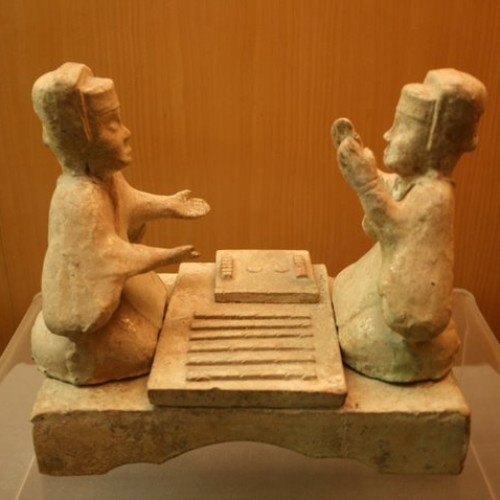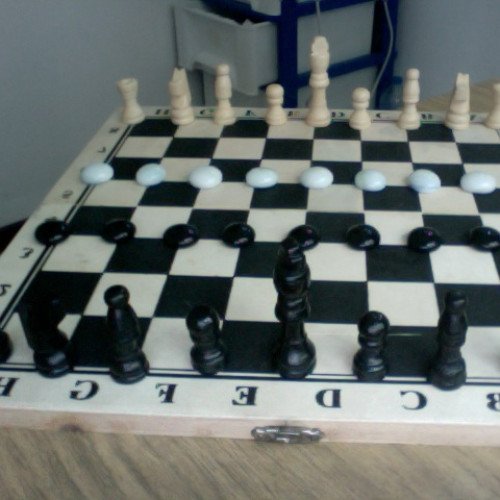LIUBO VS OUK-KHMER

LIUBO
Liubo (Chinese: 六博 or 陸博; pinyin: liù bó; Wade–Giles: liu po; lit. 'six sticks') is an ancient Chinese board game played by two players. For the rules, it is believed that each player had six game pieces that were moved around the points of a square game board that had a distinctive, symmetrical pattern. Moves were determined by the throw of six sticks, which performed the same function as dice in other race games. The game was invented no later than the middle of the 1st millennium BCE, and was popular during the Han dynasty (202 BCE – 220 CE). However, after the Han Dynasty it rapidly declined in popularity, possibly due to the rise in popularity of the game of Go, and it became totally forgotten. Knowledge of the game has increased in recent years with archeological discoveries of Liubo game boards and game equipment in ancient tombs, as well as discoveries of Han dynasty picture stones and picture bricks depicting Liubo players. It is not known when the game of Liubo originated, although according to legend it was invented by Wu Cao (烏曹, called Wu Zhou 烏胄 in the early 2nd century CE Shuowen Jiezi dictionary), a minister to King Jie, the last king of the Xia dynasty, who according to traditional chronology reigned 1728–1675 BCE. While there is no archeological or reliable documentary evidence to support the view that Liubo dates back to the Shang dynasty (1600–1046 BCE), early Chinese records do indicate that Liubo was already a popular game by the Warring States period (476–221 BCE). For example, the Records of the Grand Historian records a speech made during the reign of King Xuan of Qi (reigned 319–301 BCE) that claims that the capital city of Linzi was so wealthy that its citizens were all able to indulge in activities such as playing musical instruments, cockfighting, dog racing, playing Liubo and playing kick ball.
Statistics for this Xoptio

OUK-KHMER
Ouk-Khmer (also known as Cambodian Chess) is a chess variant which D. B. Pritchard claimed was played in Cambodia although its actual origins appear to be unknown. Pritchard gives the source as P. A. Hill. It combines elements of makruk and xiangqi. Similar to xiangqi, it is played on the intersections of an 8×8 monotone board (instead of 8×9). Contrary to Pritchard's claim, the actual variety of chess played in Cambodia today, known as "Ok" or "Ouk Chatrang", is nearly identical to makruk. The authenticity of the game described by Pritchard remains doubtful. Pritchard (The Encyclopedia of Chess Variants, 1994) described this game as "an old variant displaying elements of Burmese Chess, Chaturanga and Makruk". However, the rules provided appear to be a hybrid of Makruk and Xiangqi. For example, play on the intersections and the movement of the fish (pawn) follow Xiangqi rules. The advanced placement of the full line of pawns resembles the initial setup of makruk. The naming of the "boat" also follows makruk. John Gollon, the author of "Chess Variations: Ancient, Regional, and Modern", received a description of a chess game in 1969 from a U.S. serviceman who claimed to have obtained the details from a Cambodian born guerrilla officer he was questioning. The serviceman expressed concern that he may have been mistaken about some of the details and Gollon stated that he was never able to confirm the details with an official Cambodian source. He admitted in his letter: “The correspondent later expressed some concern that he may have been mistaken in some details.” In 2007, the English chess specialist John Beasley published a revised edition of late D.B.Pritchard's book (The Classified Encyclopedia of Chess Variants), in which more details from Gollon's letter were given (such as the local names of the chessmen, not included in the 1st edition) and where Beasley expressed his strong doubt about the authenticity of this kind of chess. In reaction to this publication, Beasley was sent information that a set of this chess had made an apparition in an exhibition in Tokyo in 2002 as well as in several Japanese books that preceded or followed, written by Umebayashi Isao and Okano Shin. They could have rediscovered these rules by translating a book bought in Cambodia, where the Elephant could not capture sideways. The names they gave for the chessmen were somewhat different from Gollon (Kwon, Neamahn, Kwo, Seh, Tuuk, Trey as for the table). Umebayashi and Okano designated that game as "shattrong". A photo of a complete set was available showing the 18 pieces on a board with marked diagonals. Beasley published a corrective note in the British specialized magazine Variant Chess (Issue 55, September 2007 and issue 64, August 2010 ) to acknowledge this second “evidence”. He acknowledged that the game is apparently absent "from the streets of Phnom Penh in 2003" and stated that Peter suggested "that this may have been a minor consequence of the mass killings of the Pol Pot era.". The situation has been cleared out in 2012 with the help of a Japanese chess researcher, Yasuji Shimuzu who got in touch with Umebayashi Isao. First, it has been now understood that Umebayashi and Okano's books were simply presenting a reconstruction of the “Cambodian” chess which they had discovered in Pritchard's first edition. As Pritchard didn't name the chessmen in his first edition, the Japanese authors extrapolated the names with the help of a dictionary. No Cambodian books had been consulted and even found. The difference in Elephant's move was simply a misreading. Finally, looking for an illustration, they just set up a set of makruk with additional Fishes and Officials over a facsimile Burmese board that they had and fitted well the size of his chessmen. John Beasley published a corrective note on his website http://www.jsbeasley.co.uk/. His conclusion is that the game described to P. A. Hill in 1969 appeared once more to reduce to a single informant whose statements were at variance with all other known testimony. Moreover, John Beasley has found and proven that the game is flawed if played seriously.